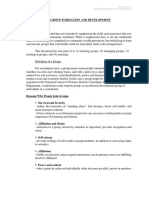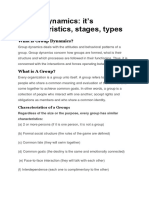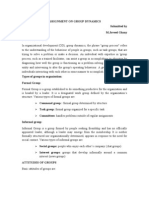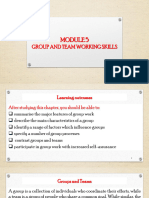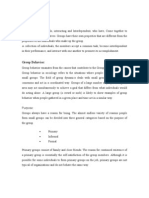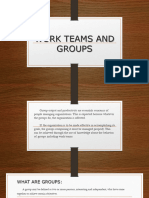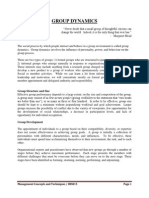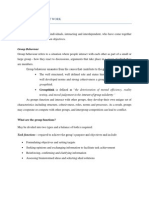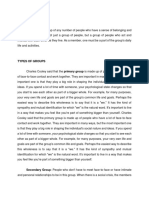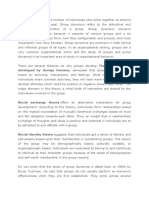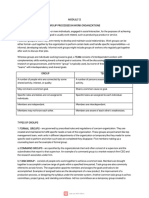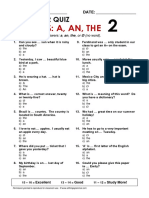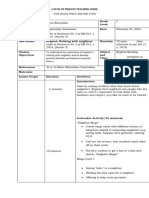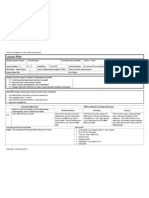GROUP PROCESS
Group process refers to how an organization’s members work together to get things done.
Typically,
organizations spend a great deal of time and energy setting and striving to reach goals but
give little
consideration to what is happening between and to the group’s greatest resource – it’s
members. While
working hard to achieve results, it is critical that members’ needs be addressed. Membership
in an
organization is as much an opportunity to develop self-confidence, refine skills and make
friends as it is
to support a cause, fundraise or educate the campus community. All of these can be done
simultaneously, but most likely will not just happen on their own.
Effective organizations take a close look at how members work together, which
roles they fill and
whether members are contributing equally. Through group process, observation and
analysis can help
identify problems early, thus alleviating the need for major overhaul as the year progresses.
Your
vantage point as a group member provides a great opportunity to regularly observe how
things are
going. Depending on the frequency of meetings and an understanding of what to look for,
you can be
instrumental in ensuring group and individual success. Process observation requires
patience and the
ability to focus on everyone in the group. Paying attention to these questions and roles can
help you to
better understand how the group is affecting its members and vice versa.
Elements of an organization that typically influence group proceedings include
communication,
participation, decision making and organizational roles. When observing these specific areas
you will
likely see several things happening simultaneously. This is to be expected, but it can also be
rather
confusing. Initially, you may want to isolate a single aspect of the group. As you become
more adept at
observation you can gradually increase your areas of focus.
● Communication
One of the easiest aspects of group process to observe is the pattern of communication:
Who talks? For how long? How often?
At whom do people look when they speak?
Single-out individuals, possible potential supporters.
The group.
No one.
Who talks after whom? Who interrupts whom?
What style of communication is used (assertions, questions, tone of voice, gestures, etc.)?
�The kind of observations we make give us clues to other important things that may be going
on in the
group (e.g., who leads whom or who influences whom). If you are uncomfortable observing
the group,
someone from the Student Activities and Leadership Center can observe your group’s
process and share
that information with you.
● PARTICIPATION
One indication of involvement is verbal participation. Look for differences in the amount of
participation among members.
• Who are the high participants? Who are the low participants?
• Do you see any shift in participation (e.g., highs become quiet; lows suddenly become
talkative)?
What are possible reasons for this in the group’s interaction?
• How are the silent people treated? How is their silence interpreted? Consent?
Disagreement?
Disinterest? Fear? Etc.?
• Who talks to whom? Do you see any reason for this in the group’s interactions?
• Who keeps the ball rolling? Why? Do you see any reason for this in the group’s
interactions?
● DECISION MAKING
Many kinds of decisions are made in groups without considering the effects that these
decisions will
have on other members. Some people try to impose their own decisions on the group, while
others
want all members to participate or share in the decision making process.
Does anyone make a decision and carry it out without checking with other group members
(self-
authorized)? For example, one person decides on the topic to be discussed and immediately
begins to talk about it. What effect does this have on other group members.?
Does the group drift from topic to topic? Who topic-jumps? Do you see any reason for this in
the group’s interactions?
Who supports other members’ suggestions or decisions? Does this support result in the two
members deciding the topic or activity for the group? How does this affect the other group
members?
Is there any evidence of a majority pushing a decision through over other members’
objections?
Do they call for a vote?
Is there any attempt to get all members participating in a decision? What effect does this
seem
to have on the group?
Does anyone make any contributions that do not receive any kind of response or
recognition?
What effect does this have on the member?
● ORGANIZATIONAL ROLES
�A variety of crucial roles need to be filled to ensure group goal accomplishment and success.
Roles are
distributed among three types:
● Task
Focused on getting things
done. Examples: initiator-
contributor, information
seeker and giver, elaborator,
orientator, energizer,
recorder.
● Maintenance
Oriented toward improving
relationships among
members. Examples:
encourager, harmonizer,
compromiser.
● Self-Oriented
Focused on personal needs
regardless of group
concerns. Examples:
aggressor, recognition
seeker, dominator, blocker.



